INTRODUCTION
This website has been constructed to allow modellers and air historians to view photographs I took of the last existing Ta 152 at the National Air and Space Museum’s Paul Garber Facility at Silver Hill in Maryland, USA. The photographs were taken in Nov 1997 when the fighter was in ‘deep storage’ and in July 1998 when the plane was being restored in the Garber workshops. They are therefore a bit old but, thanks to the very helpful staff, I was able to get some close-up photos of the outside and cockpit which I hope you will find interesting and useful. You can visit the NASM’s website at www.nasm.edu or look at the Ta152 page.
The pictures are pre-digital ‘wet film’ photographs taken with an Olympus OM2n 35mm camera with an Olympus T32 flash. The negatives were scanned at 3200 dpi in 24 bit RGB.
After photographing the Ta 152, the NASM staff gave me the opportunity to also photograph their Ju 388L-1, these photographs may be viewed here.
A BIT OF BACKGROUND ON THE PLANE
The Focke-Wulf Ta 152 was the final variant of the famous Fw 190 fighter designed by Kurt Tank.
The Ta 152 was so different to the original Fw 190 with its stubby wings and short radial engine that to the casual observer it is hard to connect the two. The Ta 152 lineage can be traced back through the ‘long-nosed’ Fw190 D variants with their powerful supercharged Jumo 213 V-12 engines designed to enhance the high altitude performance of the earlier Fw 190A series. The Ta 152 was designed to meet a specification for a very high altitude fighter. It had a redesigned high aspect ratio wing (long and thin compared to the 190’s), a lengthened fuselage, a new larger tail to compensate for the directional stability problems caused by the longer fuselage and a pressurised cockpit.

A photograph of NASM’s Ta 152 H-0 in Sept 1946 when it arrived at Newark Army Airbase in the USA. The German insignia have been overpainted with British RAF markings but much of its original camouflage remains as does the number green 4 and the remnants of a ‘J’ which signifies that it was probably once coded CW+CJ, and thus would have been W.Nr.150010.

The same plane at Wright Airfield in 1945. The plane has received spurious German markings, the code FE112 (Foreign Evaluation…) and the Green 4 looks as if it has been ‘enhanced’.
The NASM plane, the last Ta 152 in existence, is a pre-production Ta 152 H-0 model. For many years it was described (wrongly) as Werk Number 150003. It is now thought to be W.Nr.150010 (Ref.6). It was originally used for testing at Rechlin where it was coded CW+CJ. It was then transferred to the operational Luftwaffe unit JG301 where it became ‘Yellow 4’ with II/JG301 and the Yellow/Red RGV bands were painted on its aft fuselage. It ended up with the staff flight (Geschwader Stab) of JG301 where it was coded ‘Green 4’, and the green bar was painted over the RGV bands. It was flown operationally by Ofw Walter Loos in 1945. The plane was captured by the British in Denmark in 1945 and handed over to the Americans who took it back to the USA for evaluation.
In 2000 I went to the Champlin Fighter Museum in Phoenix, Arizona, USA. Alongside the famous Fw190D-13 (Yellow 10) was exhibited a Jumo 213 E-1 from a Ta 152. I’ve added photos I took of this engine as it reveals the Jumo in great detail.
Deep Storage at the Paul Garber Facility, Silver Hill. November 1997.
Deep Storage means just that, these are aircraft stored in metal warehouse type buildings and not on public view. Consequently they are hard to get to and photography conditions weren’t ideal. I was very fortunate in that I had contacted Dr Michael Neufeld, the curator of German aircraft at the National Air and Space Museum, who accompanied me to Silver Hill and allowed me to access such a rare and superb plane.
The Cockpit The main plywood instrument panel was damaged but nevertheless still contained many of the instruments. The paint was all still original and gives a good reference to the black-grey (schwarzgrau) RLM 66 colour.
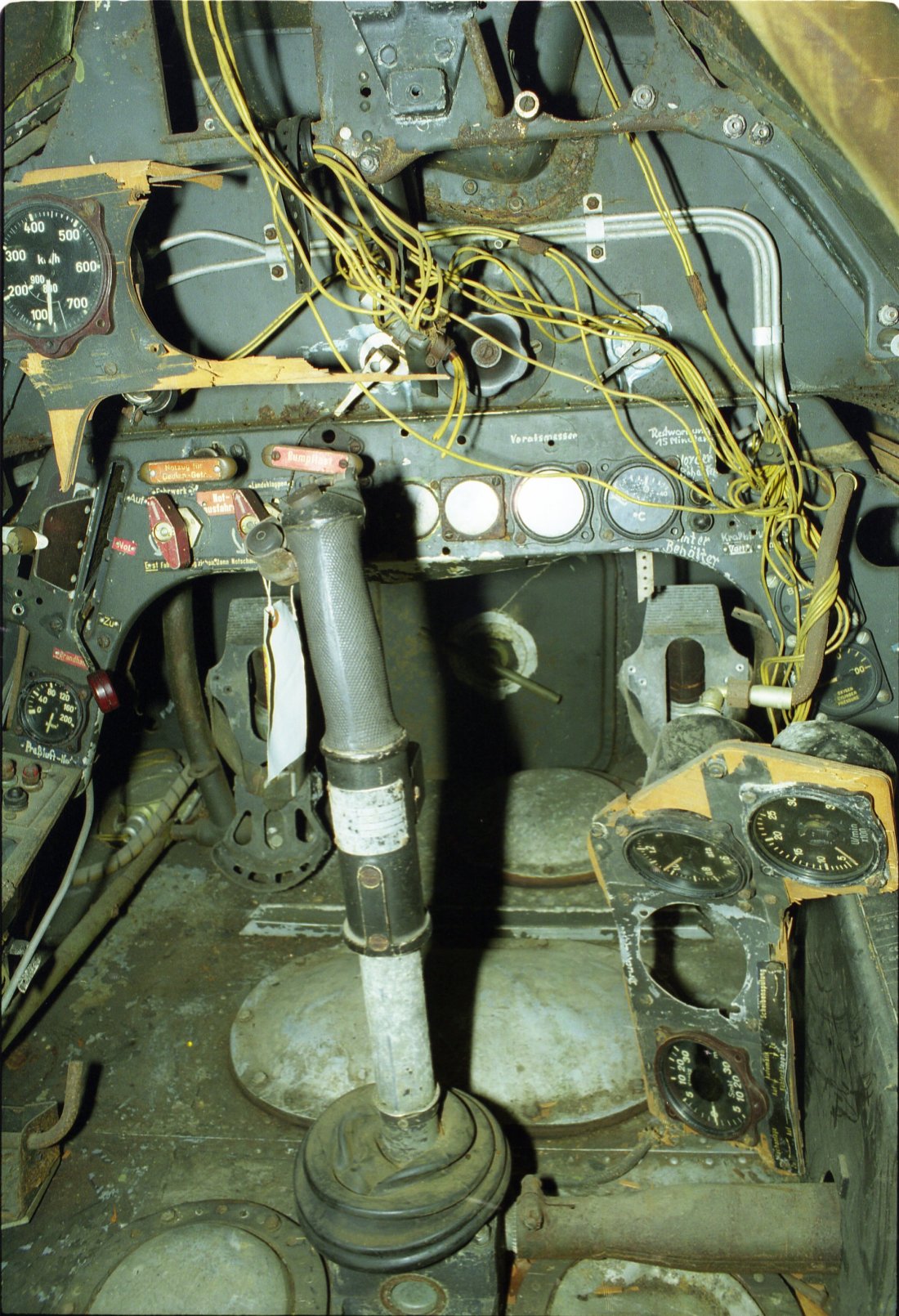
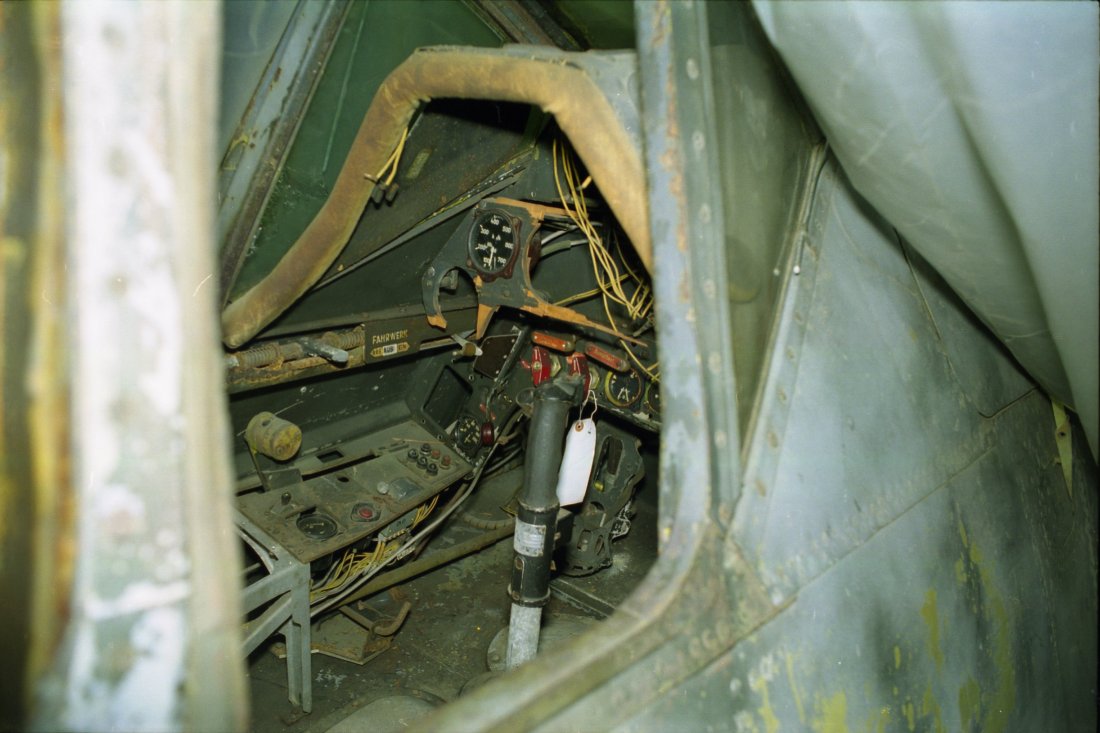
The seat had been removed giving a view into the storage compartment, the seat belts and their mountings. The main instrument panel was smashed, but it was all original.

The Canopy. To cope with the cold at high altitude and the heat in a pressurised cockpit, the Ta 152 H had a ‘double-glazed’ canopy to prevent misting, the two perspex layers were held apart by 3 inserts, containing a desiccant material, on each side. The canopy was also damaged. On the sides there are clips which engage on lugs which hold the canopy firmly in place when closed, again a necessity for the pressurised cockpit.


The Tail Area and Rudder. The rudder, wings and engine cowlings were high-up on a shelf. The rudder, placed on top of the wing, was almost impossible to photograph.
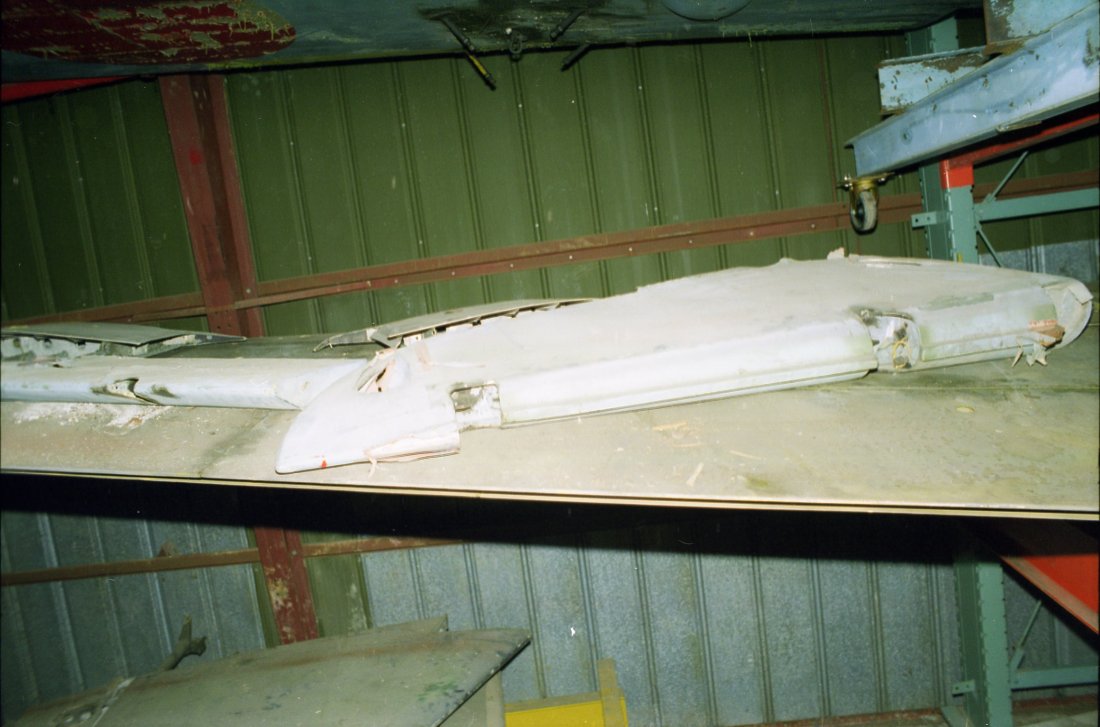
Rear Fuselage from the starboard side, the join between wooden tail and the metal fuselage is evident. The red and yellow paint was a remnant of the JG301 RVG bands, and you can see the green (faded to blue) stripe which designated the aircraft as part of the JG301 Wing Staff (Geschwader Stab). You can also see the remains of the US applied code T2-112 (originally the aircraft was FE-112, Foreign Equipment, later changed to T2, the Technical Intelligence section responsible for German aircraft evaluation).
The rectangular panel, which has had plate screwed over it whilst in the US, is where the identification signal flare chutes were located. Above that, to the right, the circular lifting hole.
The wooden tail assembly used on some aircraft, which was in dire need of restoration, did away for the need for a 0.5m metal insert (as found on the D9) to lengthen the fuselage.

Fuselage and wing root (Starboard side) The structural member of the fuselage where the wing would be bolted.
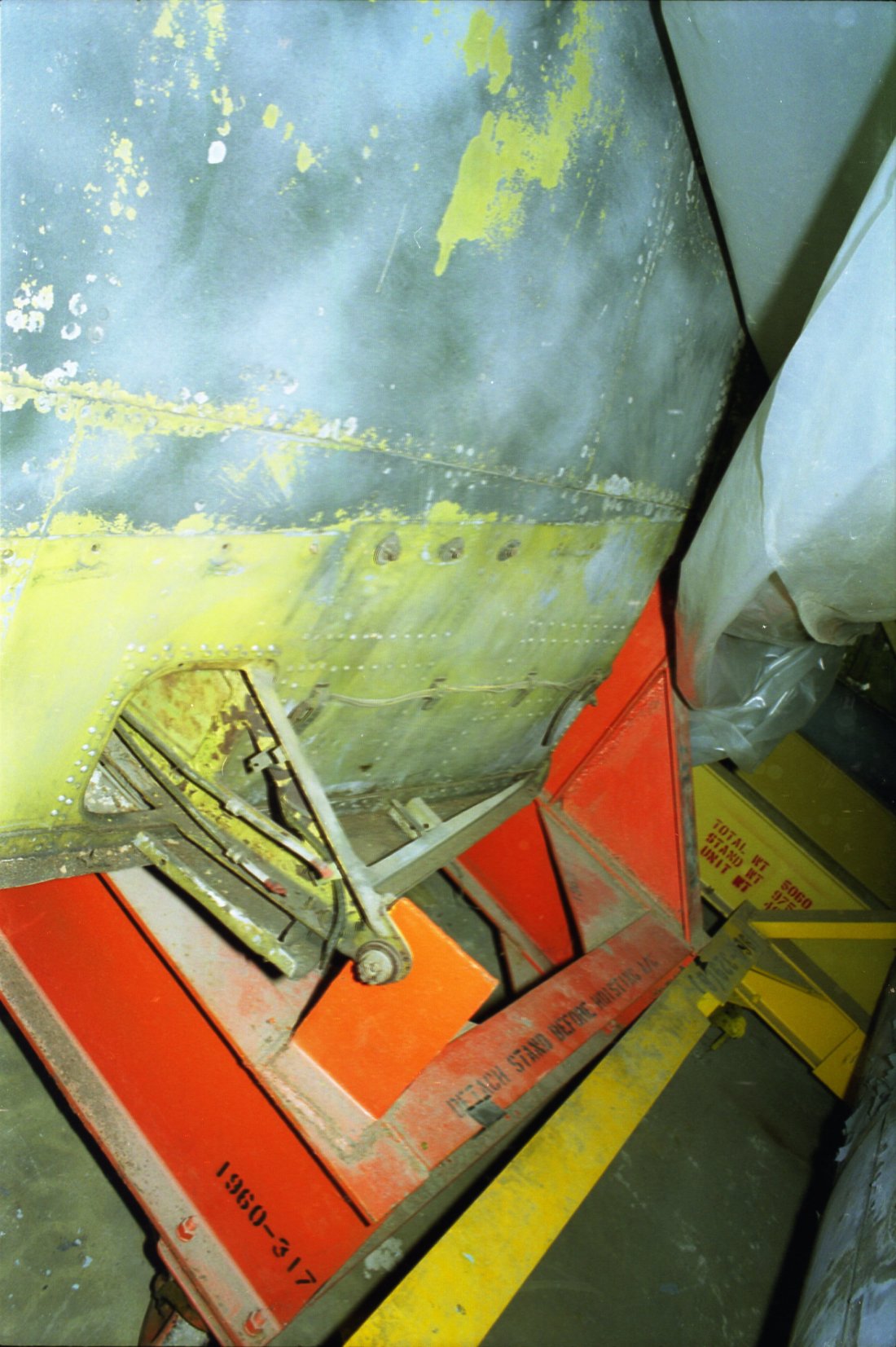
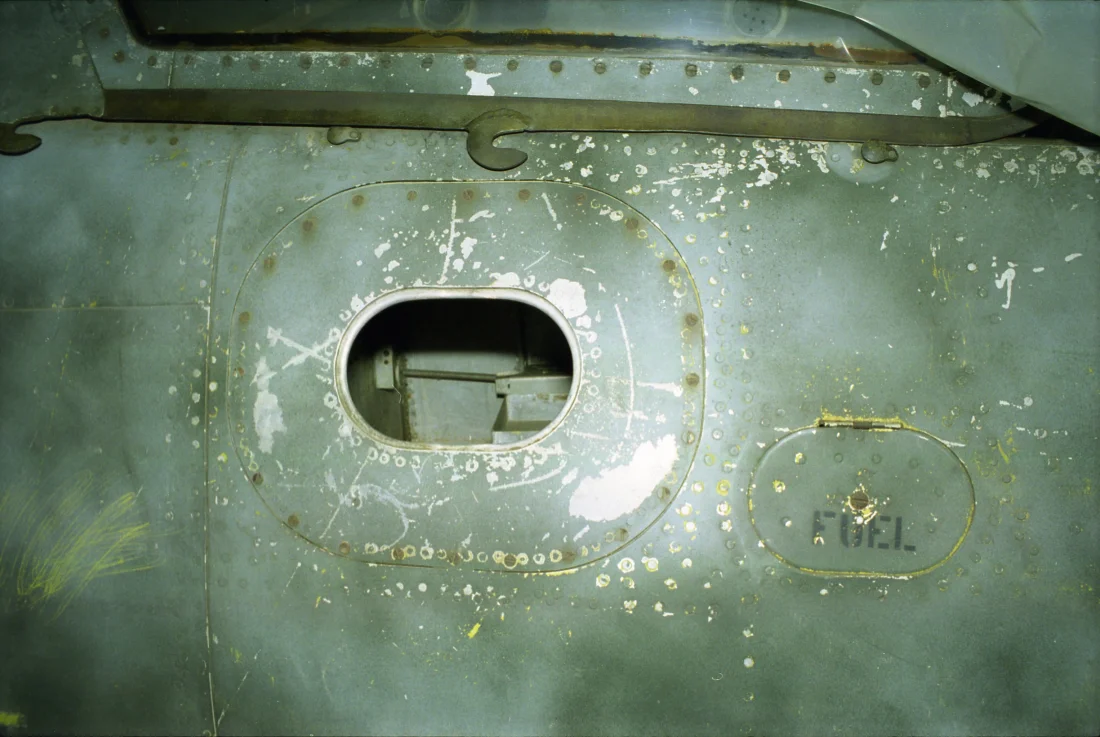

Rear Fuselage from the port side. The horizontal tailplane would have been mounted here. The structure of the wooden unit shows up clearly.

Wings. The wings were high on a shelf, not ideal for photography. Nevertheless they confirm it as a Ta 152 H-0, pre-production aircraft. You can count 9 circular access holes for servicing the control linkages. On the right, towards the wing root is a rectangular hole. The H-1 had 3 circular holes here to access the wing mounted fuel tanks which were absent in the H-0’s wing. You can just see the ailerons and rudder sitting on top of the wing. Below the wing is the starboard engine cowling with its supercharger intake.



Firewall, Engine Mounts and Cannon Bay. These images show the mounts for the Jumo 213 E1 engine. Further back is where the Mk 108 30mm cannon would have been mounted. You can see the ammo feed and cartridge ejection shoot. The inside is left unpainted, natural aluminium rather than RLM02 Grey. At the very back is the hatch into the cockpit compartment. The engine was nowhere in sight, nor the VS9 prop and spinner.



RESTORATION – July 1998
When I next visited the Garber facility in 1998, the Ta 152 had been moved into the restoration workshop and was beginning to look in better shape. The engine has been re-attached and work begun on the cockpit, fuselage and tail surfaces.


THE COCKPIT The double-glazed plexiglass canopy (outer thickness – 8mm, inner 3mm) is fitted. You can see the rollers in their fuselage runners and the fix of the head armour to the cockpit sides.
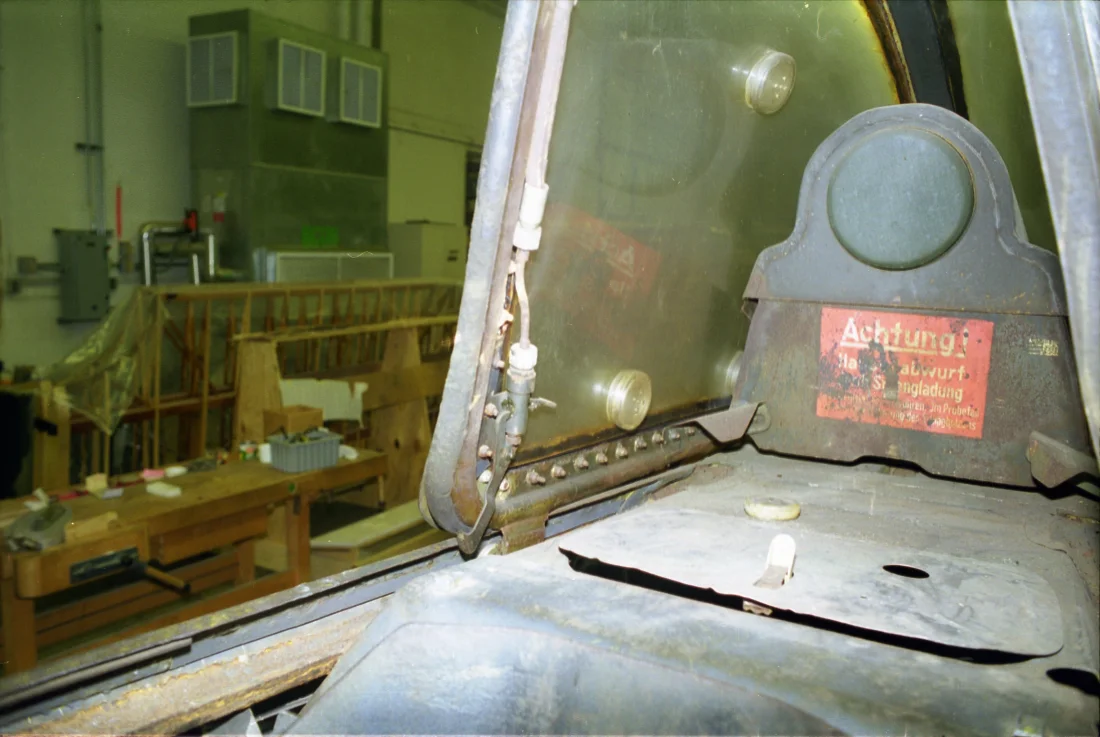

The rear part of the left hand console has had to be re-built from wood (as the original would have been). The rear part housed radio controls, the connection to the pilot’s heated suit and the engine priming pump which is still fitted.
The main instrument panels had been re-built with instruments re-fitted. At the top, the Revi gunsight and ammunition counters were still missing. The yellow tag hanging from the wiring indicates that the instruments are radioactive, they were painted with radium paint, still active and hazardous.

The new panel is a different colour to the original damaged panel that was present in 1997.
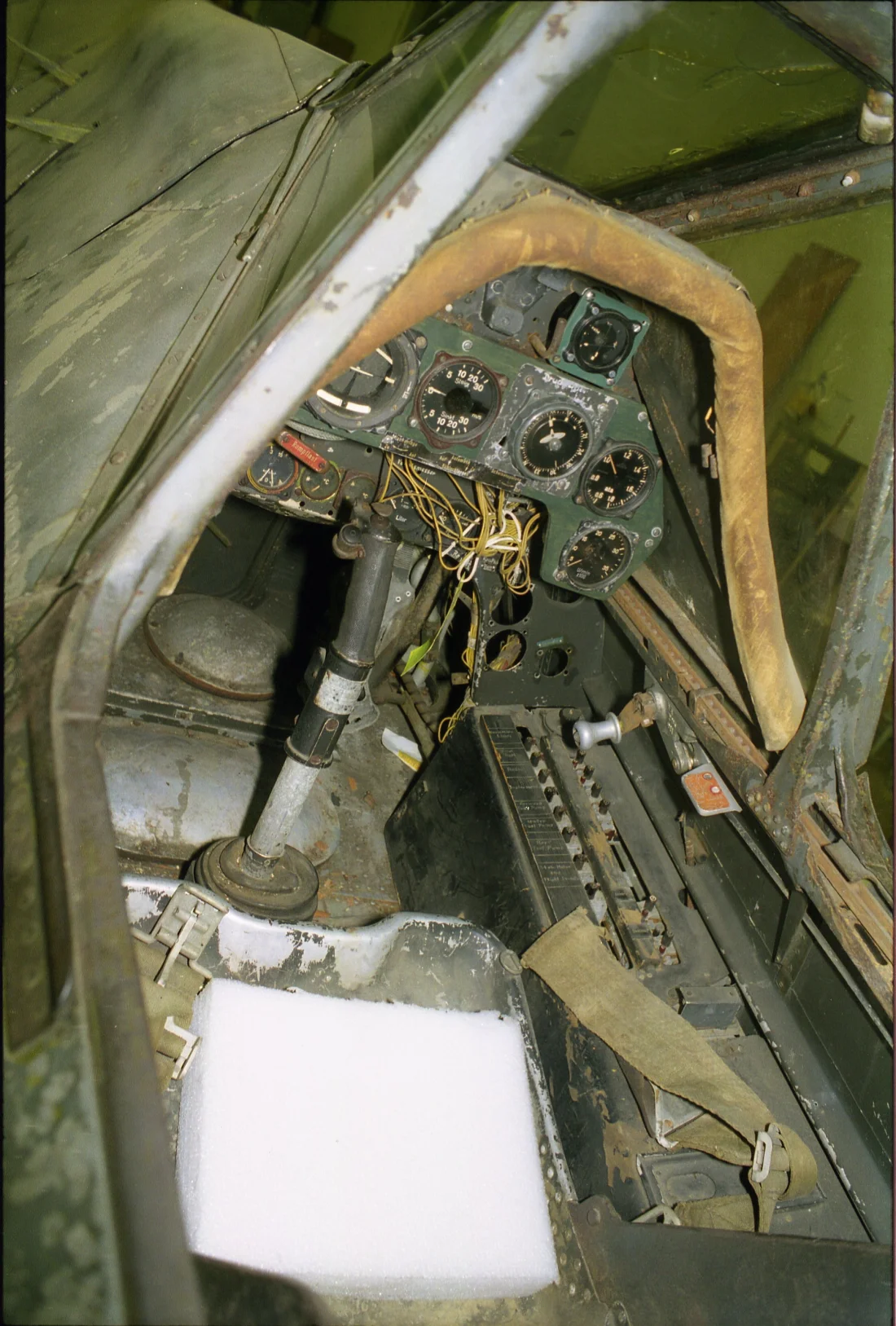
The seat had been refitted, the white block is some polystyrene to prevent further wear as the staff climbed in and out of the plane.

The right-hand console contains automatic switches and, to the rear (just above the seatbelt) the starter switch.
THE TAIL

Much of the woodwork of the tail has been repaired and the old markings are disappearing. You can still see the remnants of the US code, FE-112 (FE for Foreign Equipment, later changed to,T2-112). Also visible is the red, white and blue of the British RAF insignia, applied before it was handed over to the US forces. The NASM staff were great about showing us the plane and describing the restoration. In the foreground are the elevators. Made of wood, these had deteriorated quite badly and needed considerable rebuilding.

The starboard side of the tail also reveals the old British marking and the small, incorrectly angled, swastika applied in the US. The NASM restorers have outlined the much larger H3 type plain black swastika that would have been applied when operational.

FUSELAGE
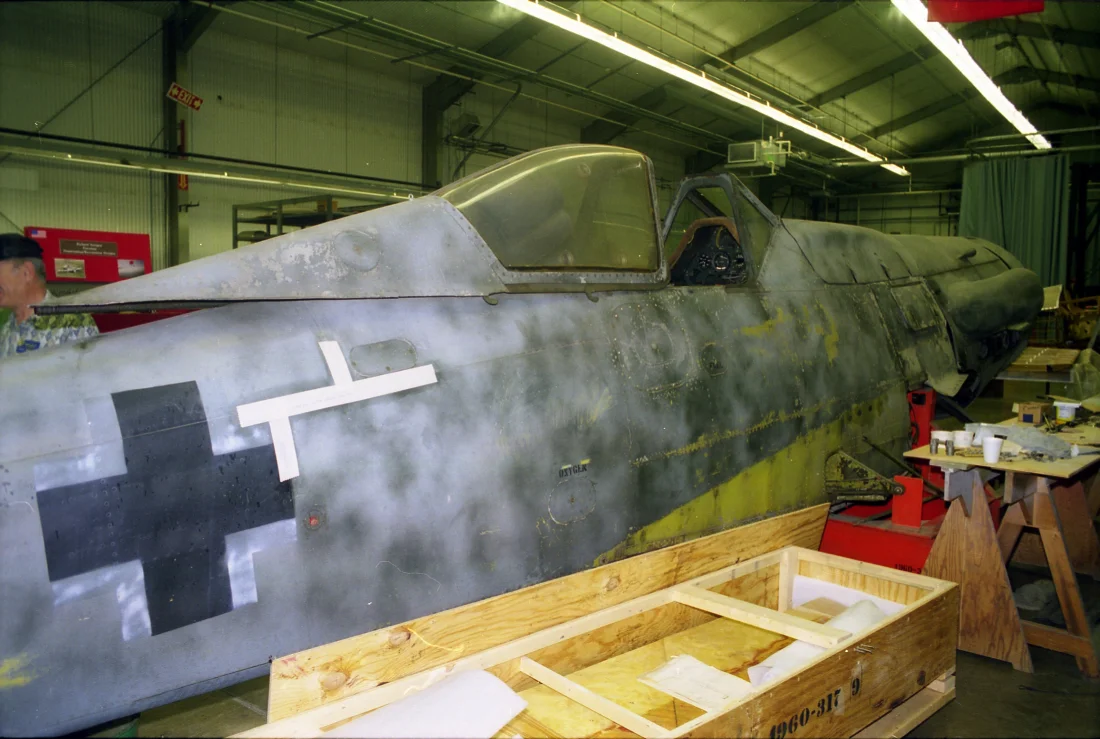

The camouflage is left over from a spurious paint-job done when the plane arrived in the USA, underneath which is a layer of yellowish zinc-chromate primer applied in the US.
THE ENGINE

Note the grill in the supercharger intake which was an addition in the US. This has been included incorrectly by scale model manufacturers. If you wished to model the plane as it was when operational it should be removed.
The NASM staff, knowing I was interested in photographing the Ta 152, gave me some time to get up-close to the plane before the tour started. Whilst I was lucky enough to get a couple of minutes, one always regrets photographing in a hurry. Like, why didn’t I take the rag of the prop shaft? And I should have got some decent close-ups of the supercharger intake.


A view of the engine plumbing, one advantage of not having the wings fitted.
Ta152-H1 Engine
A Jumo 213 E-1 Engine was on display at the Champlin Fighter Museum at Phoenix, Arizona, USA. Doug Champlin acquired it from an automobile collector in California in 1982. However the museum closed in 2003 and its collection was moved to the Museum of Flight at Seattle‘s Boeing Field, I have been unable to confirm whether the engine is still with the collection or on display.
The engine would have been identical to that fitted to the NASM Ta 152 H-0. The attraction of the Champlin engine is that it is completely exposed.
Both Merrick in his book German Aircraft Interiors and Hitchcock (The Focke-Wulf Ta 152) mention that it is possible that the Champlin engine came from Ta 152 H-1 W.Nr 150167. Comparison to a WW2 photos of 150167 strongly supports this in terms of the general paint application and the scratches to the paint on the starboard side of the radiator cowl.
In these photos (and others published) the colour of the remaining front engine cowling looks like RLM 75 Grauviolett. However, Jerry Crandall has compared actual colour chips with the cowlings and concluded that they were originally painted in Dunkelgrün (Dark Green) RLM 83, which has faded over the years.
On the engine and the supercharger you can see the number E1-216. This is the engine’s Werk Number. It is also stamped on the dataplate and the engine block itself, just below the dataplate.
Thanks to the National Aerospace and Space Museum staff (especially Dr Michael Neufeld the Curator of German aircraft) who were very helpful in allowing me access to the Ta 152 H-0.
Also thanks to the staff at the Champlin Fighter Museum who let me photograph the Fw 190 D-13 and the Jumo 213 E-1 engine.
References. Books I’ve found useful in my research and in building this site:
1. Focke-Wulf Ta 152 by Dietmar Harmann published by Schiffer, 1999, ISBN 0-7643-0860-2.
2. German Aircraft Interiors, Vol 1, by Kenneth Merrick published by Monogram, 1996, ISBN 0-914144-41-3.
3. War Prizes by Phil Butler published by Midland Counties, 1994, ISBN 0-904597-86-5.
4. Monogram Close Up-24 Ta 152 by Jeffrey L. Ethell, published by Monogram Aviation Publications, 1990, ISBN 0-914144-20-0
5. Yellow 10 by Jerry Crandall published by Eagle Editions, 2000, ISBN 0-9660706-3-1.
6. The Focke-Wulf Ta 152 by Thomas H. Hitchcock, published by Eagle Editions, 2010, ISBN 978-0-914144-53-3
Any comments, corrections or suggestions? Email me at: fockewulftank152h0@gmail.com
This website was originally constructed in 2001 and hosted on Yahoo Geocities. I have updated the site and all the pictures have been re-scanned from the negatives giving far better resolution, clarity and hopefully more accurate colour rendition.
Link to my website on the NASM Junkers Ju 388L-1, photographed on the same visit
Link to photographs of the Horten Ho 229 photographed during a tour of the Garber Facility in 1997.
Copyright. Other than the 1945 photos at the start, all other photos / images in this website are owned and copyright C.Silverlight 2018. However, please download and use them. If you re-use them for another publication, I would be grateful if you would provide an acknowledgement. Thanks.
1945 photographs at the start are the work of a U.S. Air Force Airman or employee, taken or made as part of that person’s official duties. As a work of the U.S. federal government, the image or file is in the public domain in the United States.



















